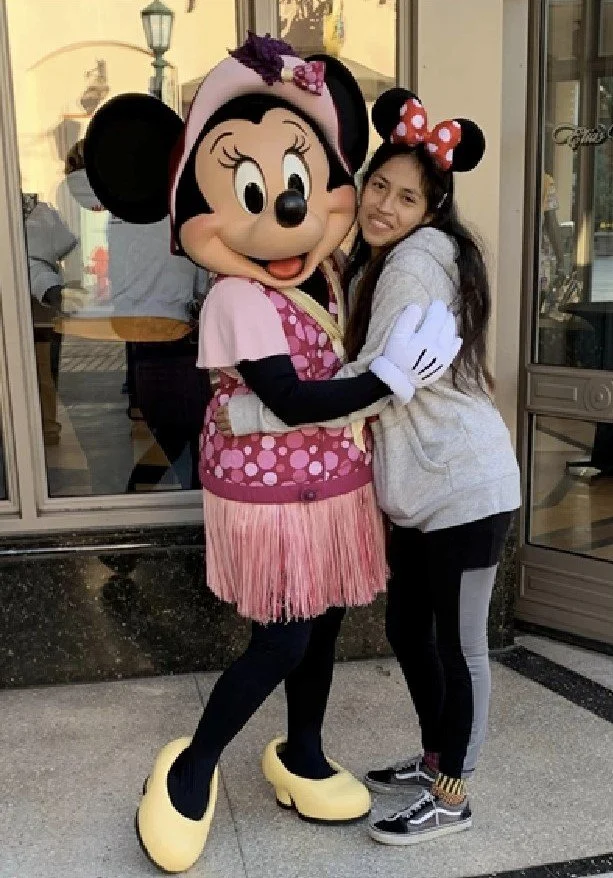Tips for Visiting Disneyland Differently
By: Holly Kreider
drhollykreider@wishesfamilytravel.com
August 22, 2023
Amusement parks are arguably the most stimulating environment on the planet. In other words, not always the happiest place on earth for children with anxiety, autism spectrum disorder, ADHD, and other learning differences. But a fantastic recent trip to Disneyland with my 19-year old daughter, who loves Minnie, but also fears dark places, germs, crowds, outer space, and men in uniform, restored my faith. (Note photo and story are both shared with her permission!).
A little extra planning can go a long way to ensuring a magical experience. Here are some ideas and resources to put the magic back in Magic Kingdom.
Plan Ahead
Preview the park and its rides online before visiting. Make a plan that reduces situations and experiences that could aggravate anxiety, while also bringing “tools” to address anxiety in the moment. Talk it up in advance!
Choose the least crowded days, weeks, and months to visit. Try a Monday in March. Refer to this Disneyland crowd calendar.
Access the park early using early entry privileges by staying at a partner hotel, so you can enjoy the park during its quietest hours.
Build flexibility into your travel package. Consider a multi-day pass, park hopper ticket, and hotel nearby, so your child can have a break from the park and easily return later in the day or change to a different park.
Visit websites focused on making Disney parks accessible to everyone, like Diz-abled.com and Disney’s official Disability Access Service (DAS) webpage and resource guide for guests with cognitive disabilities.
Ride in Style and Stress-free
Keep track of your child. Consider a neon shirt, an iTag, a charged iPhone, or an old-school phone number written in marker on your child’s forearm to keep tabs on them. Agree upon a tall landmark inside the park as a meeting place if your child gets lost (like Matterhorn or the princess castle at Disneyland). Make sure your child knows to ask a park staff person for help if they get lost. Familiarize yourself with the “lost child” location at each park (usually near First Aid).
Secure a Disability Access Service pass, if eligible, to avoid long waits and crowded lines that may trigger panic attacks or make a quick exit more difficult. DAS passes can be requested at Guest Services located at City Hall on the left just beyond entry gates. Popular rides still require a timed entry, but the wait time is less, the line is separate and less crowded, and your timed entry never expires.
Take advantage of the child switch program when a ride feels too scary, allowing one adult to stay with the child in a waiting area, while another goes on the ride, then switch so the first supervising adult gets a turn to ride, while the child is safely with the other adult.
Don’t forget shows and experiences as mellower alternatives to rides, like the Disney Main Street parades, Opera House, Fire Station, and Steamboat Cinema; the enchanted Tiki Room; Tarzan’s treehouse; and California Adventure’s World of Color outdoor evening show.
Manage fear of characters. Only if your child is willing and interested, you can watch characters at designated areas from a distance, interact first to model for your child, and/or bring along an autograph book for a distraction. A character meal is also an option. Featured characters tend to be less scary (like princesses and chipmunks). Ask for a booth near a wall and give your child an inside seat or even ask for the characters to skip your table.
Find your Zen
Seek out nature experiences, like Disneyland’s Tom Sawyer Island or the Explorer Canoes for some temporary tranquility.
Utilize quiet spaces. Ask park staff to mark quiet areas on your park map, like less traveled paths, benches, post-ride areas, First Aid, and baby nursing areas. Seek out family restrooms, which often have manual flushing for sensory sensitive children.
Pack your invisible suitcase - full of tools like deep breathing, meditation, and social stories – to use whenever you need it.
Pack a real backpack or fanny pack with whatever helps your child. Consider earplugs or noise-canceling headphones if loud noises are an issue. Bring a charged iPad and charging rod. Bring a fidget spinner, favorite snacks, or a stress ball. Bring emergency anxiety medications.
Look for inclusive lower-stim areas, like Disneyland’s redesigned ToonTown, with a soft color palette, calming music, muffled sounds, and more green spaces.
You are your family’s best Imagineer! So dream big and make it happen. Together we can ensure that Disneyland is not just a small world after all, but also an inclusive one.

